Sky’s the Limit
| July 9, 2024A rebranded frum-friendly El Al upgrades its image and its bottom line

Photos: Jeff Zorabedian
When El Al was bought out by an Orthodox company in 2020 following reported losses for several consecutive years, the Israeli national carrier realized that becoming a frum-friendly airline could have a significant impact on its bottom line. And so, after years of Shabbos wars and other threats, the airline has rebranded itself not only as an entity embracing its Israeli heritage, but its religious roots as well
Stashed amid the bins of in-flight snacks and kiddie coloring books in the rear galley of the Boeing 787-9 Dreamliner, the blue metal box holding ten ArtScroll iPads that are available for passenger use pretty much sums up the new EL AL. Over the past four years, Israel’s national airline has evolved, and the many facets of its signature sabra personality now also include a distinctly chareidi vibe.
JetSetting
Despite having flown more than ten times over the past year, including twice on Dreamliners, I jumped at the opportunity to take a personal tour of an EL AL aircraft. It wasn’t just about seeing how the other half lives (here’s looking at you, business class, with your lie-flat seats and capacious elbow room), it was also a great opportunity to take in EL AL’s latest enhancements, designed to woo travelers just like me.
I met up with photographer Jeff Zorabedian at Newark Liberty International Airport’s Terminal B. Olivia Lagdoue, who works with EL AL’s contracted ground operations team at Newark, took our passports and handed us tickets for standby seats on the midday flight to Tel Aviv, which would allow us to get through the terminal. Unsurprisingly, getting near the EL AL 787-9 Dreamliner just four hours prior to takeoff was quite a feat. While we were escorted through the terminal and whisked through various lines, we still had to go through security, and even my TSA-PreCheck status didn’t spare me from having to remove my shoes and send my bag down the conveyor belt to be x-rayed.
We waited at the gate for about 15 minutes before Lagdoue led us down the jetway and onto the plane, where we were greeted by two badges of honor. The first was a black-and-gold decal affixed to the outside of the aircraft proudly proclaiming EL AL as an APEX five-star global airline, a distinction it could not have dreamed of until recently, and the second, a white plaque mounted to the wall at the doorway bearing the words of Tefillas Haderech in blue lettering. At the bottom of the plaque were the Hebrew words, “Tzeischem u’voachem l’shalom” (May your departures and arrivals be in peace), making it clear to passengers from the minute they board that even though there is a flight crew operating the massive jet, the true Pilot is in a realm far above cruising altitude. By the same token, it comes as no surprise to hear that on some flights, the crew has been known to say Tefillas Haderech over the PA system, reiterating EL AL’s ironclad belief that first and foremost, its entire fleet is in Hashem’s hands.
While many parts of the Dreamliner are utilized the same way on every airline, there are some features on this craft that are uniquely EL AL, including the airline’s custom-designed washing cups, created to meet the needs of the frum traveler. A smaller version of the two-handled washing cups that exist in practically every Jewish home, each one holds 195 milliliters, nearly 6.6 ounces, more than the required amount of water for netilas yadayim, with brackets installed next to the lavatory sink keeping the cups neatly out of the way when not in use. A prototype of the cup from its initial design stages sits proudly on a shelf in the office of EL AL chief operating officer and deputy chief executive officer Omry Cohen, who has been with the airline since 2020, and has initiated or overseen many of the new frum-friendly services and features that El Al has rolled out in recent years.
Oops! We could not locate your form.







